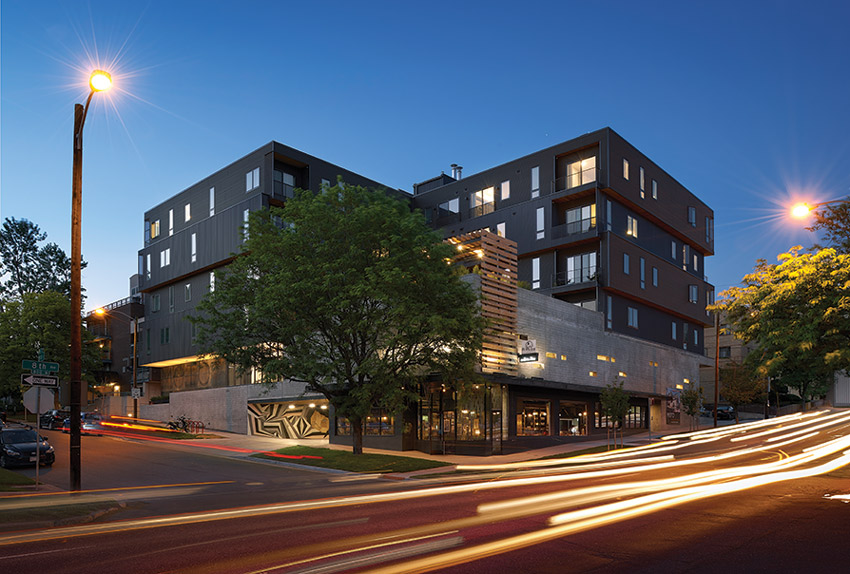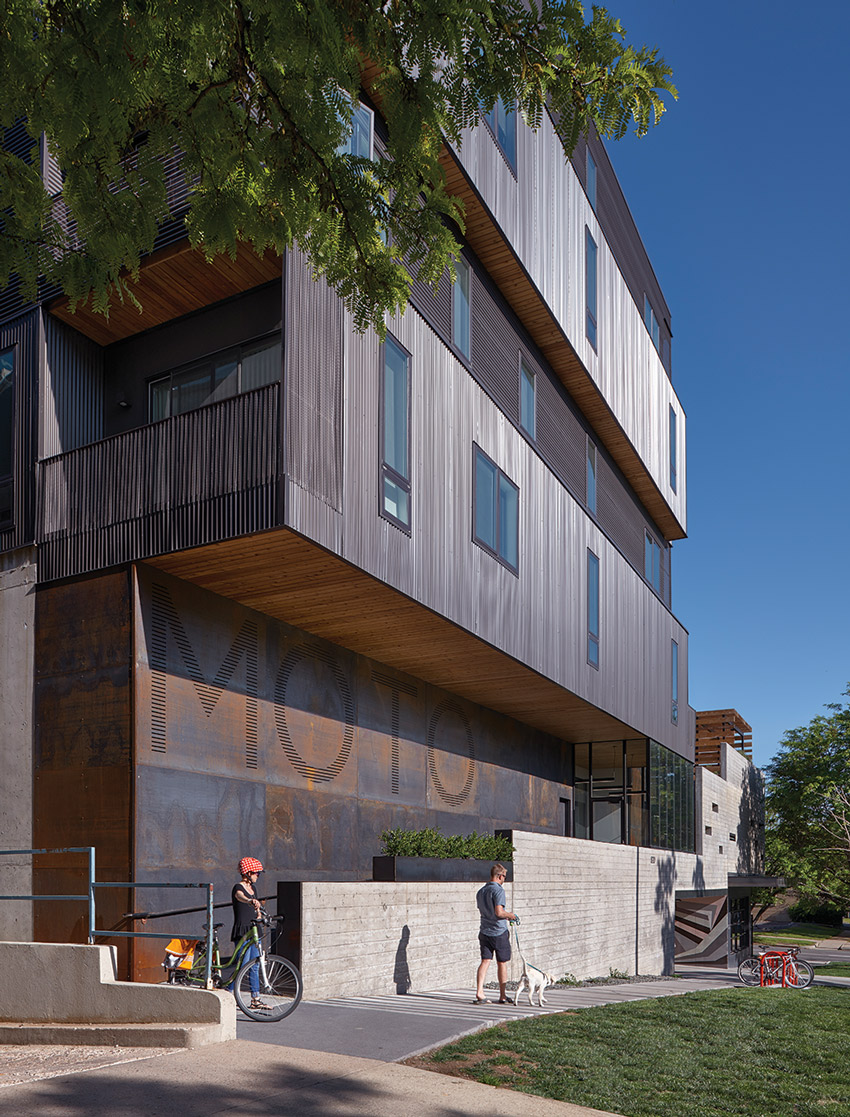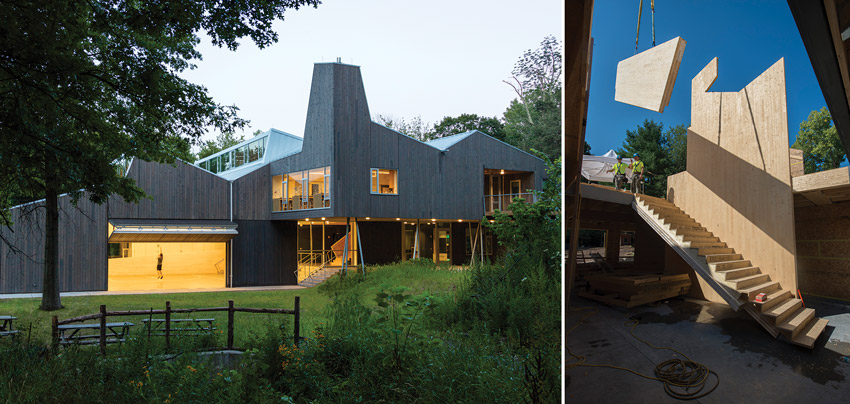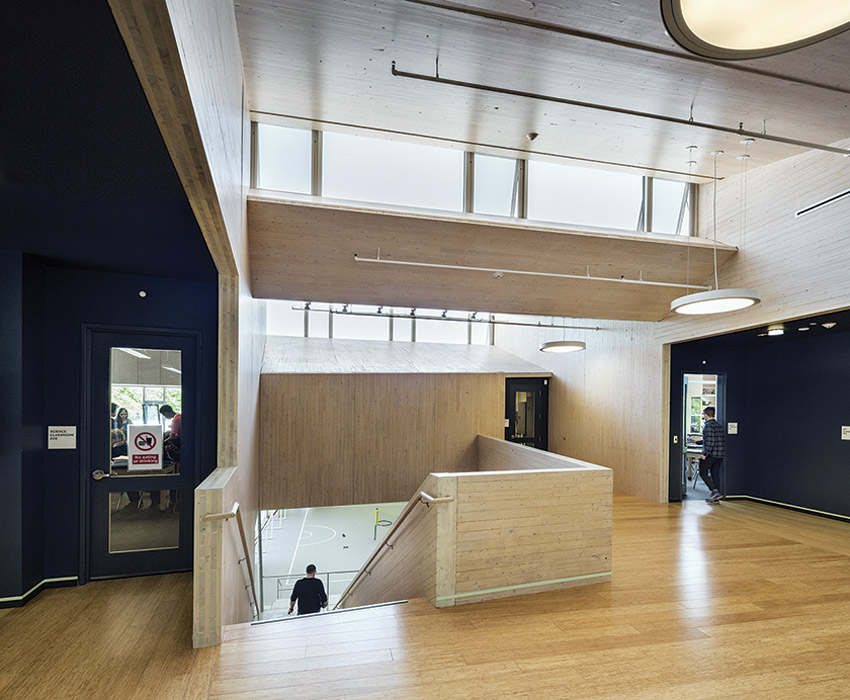Designing Sustainable, Prefabricated Wood Buildings
![]() Continuing Education
Continuing Education
Use the following learning objectives to focus your study while reading this month’s Continuing Education article.
Learning Objectives - After reading this article, you will be able to:
- Demonstrate why prefabrication is an efficient and sustainable building practice.
- Evaluate the use of wood components in sustainable prefabricated buildings as well as design and engineering challenges that wood can solve.
- Discuss the advantages of building with prefabricated wood components in terms of speed and efficiency of construction, design flexibility, waste reduction, environmental performance, and improved life safety.
- Analyze, through case studies, the different stages of wood building prefabrication from design to installation.
Prefabrication Then and Now
Prefabricated wood buildings should be considered when designing and building both multifamily and commercial buildings, such as multifamily housing, education, retail, health-care, and institutional buildings, as prefabrication is an efficient and sustainable building practice. Prefabricated wood components used in both light wood-frame and mass timber construction can help to solve many design and engineering challenges, such as material and process efficiency, environmental performance, and life safety.

Image courtesy of Lawrence Anderson
The practice of prefabricating building elements in a factory was adopted in the United States only in the past century. Prior to that, most buildings were constructed on-site. There was a boom in kit-of-parts building post World War II. Consumers were enthralled with industrial production and replication, aka mass production, and prefabricated buildings helped fulfill the need for affordable, quality housing post war. Although mass production has remained vital to our economy and almost all industries, interest in prefabricated buildings fell off in the 1970s. The design and construction industry did not fully embrace the concept because it wasn’t well integrated into its traditional business model.
The building industry is now embracing digital tools such as 3D modeling, building information modeling (BIM), and computer numeric control (CNC) machines, making prefabrication and communication amongst building professionals easier. As James Timberlake, FAIA, says in the foreword of Ryan Smith’s book Prefab Architecture: A Guide to Modular Design and Construction, “We are now capable of sending a fully visualized and virtually formed model to a production line, bypassing the document interpretation phase, with all of its back-and-forth checking, redrawing, and margin for additional errors and omissions, ultimately improving the quality of the final product.” Also, improved safety measures and greater productivity are now high priorities, which prefabrication can help achieve. The off-site construction environment is a way to provide workers with safer working conditions to reduce the risks of accidents and related liabilities.
An increase in productivity is especially important because of the high demand for but short supply of skilled labor in the construction industry. Some believe that standardizing and automating construction in a factory setting deskills the traditional trades. In reality, it upskills the industry and prepares the trades to efficiently deliver buildings through technologically advanced design, fabrication, logistics, and assembly. “We think the recession actually benefited our industry,” says Thomas Hardiman, executive director of the Modular Building Institute. “During the last recession, many skilled laborers left the construction industry and did not return. That, coupled with developers needing to find greater efficiency, made prefabricated buildings more appealing. The construction industry is very reluctant to change. When things were going well, developers and general contractors may not have felt the pain or need to change. Now they do, and there’s no turning back.”

The building industry is now embracing digital tools such as 3D modeling, building information modeling, and computer numeric control machines, making prefabrication and communication amongst building professionals easier.

Wood prefabrication has a multitude of benefits, including process efficiency, a controlled environment, a greater return on investment, material efficiency, reduced waste both on- and off-site, and sustainability.
In addition, environmental views are changing regarding construction waste, the product supply chain, reuse of building materials, and carbon footprint. Wood buildings, particularly prefabricated components, can help designers balance cost objectives, function, and environmental impact. Timberlake says, “Integration modeling, the backbone of off-site fabrication and manufacturing, leans the product supply chain, helps architects and contractors manage the number of materials needed, and allows for a positive repurposing of the leftover materials. Further, off-site assembly offers the promise of disassembly and re-use.”
Benefits of Wood Prefabrication
Wood prefabrication has a multitude of benefits, including process efficiency, a controlled environment, a greater return on investment, material efficiency, reduced waste both on- and off-site, and sustainability. All of these benefits help to meet demands from owners, designers, and tenants for better buildings. Process efficiency is possible at every stage, from design to fabrication to construction. Detailed planning allows construction processes to be standardized and streamlined, including construction efficiency that meets aggressive schedules and decreases on-site assembly time. Sequencing is improved, as prefabricated components are sorted and loaded onto trucks, minimizing on-site handling. The process is also more integrated with better communication amongst parties, which reduces costly change orders.
Because prefabricated components are produced in a controlled environment, quality and precision of components improve, fabrication productivity increases, safety for tradespeople improves, and weather is not a factor in slowing down the construction process. Budgets should be easier to meet because redundancies and waste in both materials and time are streamlined. Although building components are often more expensive up front, the complete installed cost is usually less because on-site construction is minimized. Material efficiency results because prefabricated components are made off-site and typically via modeling technologies that provide extreme precision. Reduced waste both on- and off-site minimizes the environmental impact of a project, as specific sizes and dimensions of components are determined in advance and components are made or cut to tight specifications. This also relates to the sustainable nature of prefabrication.
According to Ryan Smith, author of Prefab Architecture: A Guide to Modular Design and Construction, “The environmental impact of building requires a quantifiable measurement of impact in total life cycle from design through facilities management. By controlling the means and methods by which buildings are produced through prefab, architects and construction professionals are able to ensure more sustainable materials and practices for construction as well as have a greater opportunity to predict future energy performance. Prefabrication may be used as a method to revamp the sustainability of construction from the perspective of the total life cycle of a facility, especially regarding demolition or reuse, as the case may be. The capacity of prefab to deliver buildings that respond to time, change, and reuse/recycle may be its greatest benefit toward total life-cycle sustainability in the future.”
We will review several case studies that demonstrate these benefits, including an extensive case study to conclude the course that details the process of erecting a prefabricated building from design to construction.
Prefabricated Wood Construction
Prefabricated wood buildings are no longer limited to single-family housing and smaller temporary workspaces but are now being constructed for innovative buildings demanded by tenants and owners. Sectors with redundancies, such as multifamily housing (e.g., condos, student housing and senior housing), education buildings, commercial retail, health-care, and institutional buildings, are more likely to be built prefabricated.
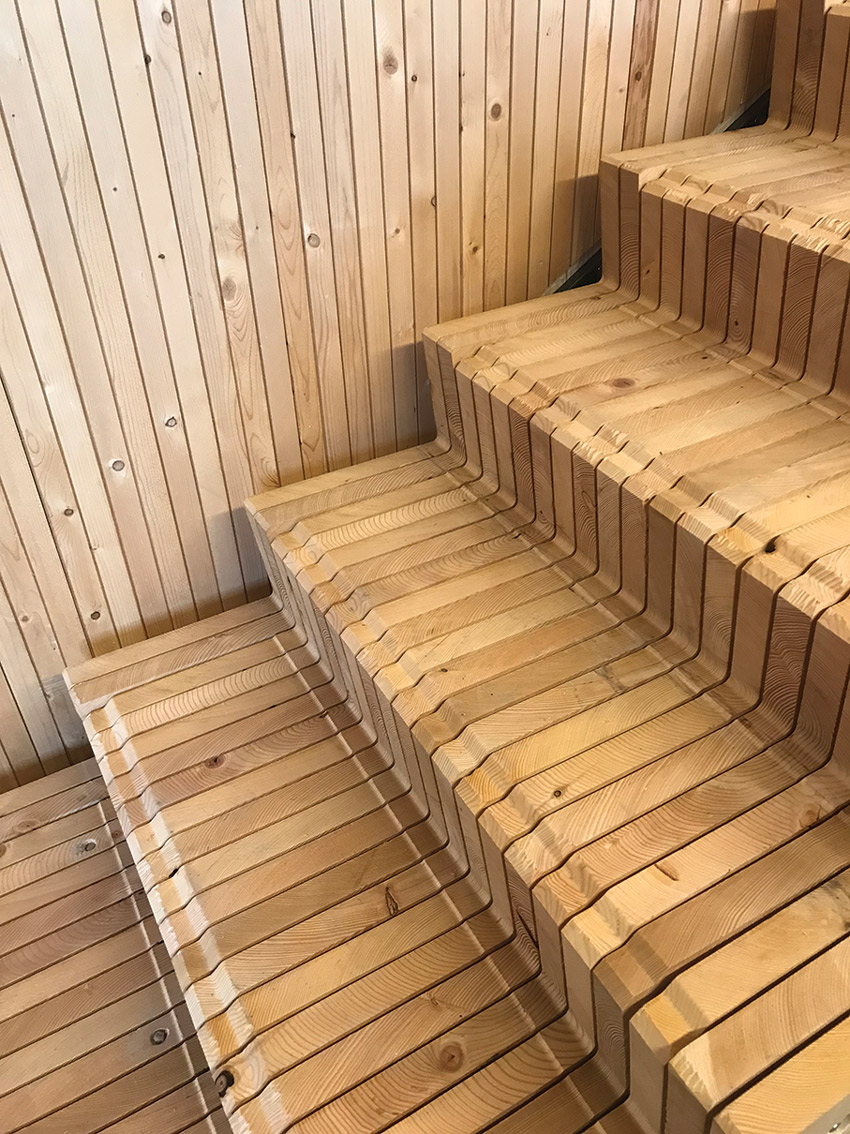
Image courtesy of StructureCraft
Computer numerical control machining technology is used at the plant to profile wood panels for installation, and sophisticated connection systems with a high degree of accuracy and efficiency are incorporated during prefabrication.
Wood has many benefits to the building industry, including aesthetics, environmental performance, strength and rigidity, lighter weight (compared to concrete), and energy efficiency. In prefabricated buildings, wood is particularly beneficial; it has the structural simplicity needed for cost-effective projects and design versatility, and it can be rapidly installed with reduced waste.
Prefabricated wood wall and floor panels offer easy handling during construction, and a high level of prefabrication facilitates rapid project completion. This is a key advantage, especially in midrise construction from five to 10 stories. Lighter wood panels mean that foundations do not need to be as large and smaller cranes can be used to lift panels higher. For example, at the four-story John W. Olver Design Building at the University of Massachusetts Amherst, four 60-foot-tall cross-laminated timber (CLT) panels comprising one of the building’s shear wall cores were lifted and dropped into place with a crane and anchored to the foundation, all in one weekend.
Panelization means framing of dimension lumber or mass timber walls produced with a high degree of accuracy in a factory. Computer numerical control (CNC) machining technology is used at the plant to profile wood panels for installation, and sophisticated connection systems with a high degree of accuracy and efficiency are incorporated during prefabrication. Panelizing lowers cost and speeds up the delivery of walls to a site where framing crews install quickly when compared with on-site framing. The faster and safer contractors and developers can finish a building, even if off-site construction methods are more expensive, the greater the return on investment. For light wood-frame construction, on-site framing is still the norm because it continues to make sense from a quality vs. cost perspective, but that is slowly changing. In the future, larger projects that demand panels be erected quickly and en masse are more likely to be prefabricated for light wood-frame construction.
Types of Wood Prefabrication
There are two types of industrialized approaches to prefabricated buildings: building kits (kit of parts) and finished modules. Building kits include prefabricated elements or sections that are then delivered and assembled on-site. These may include the roofing package (roof panels, fascia, gutter, etc.), roof structure (ceiling deck and beams), glazing package (windows and entrances), and building structure (wall panels, beam pockets, columns and shear paneling). The kit-of-parts approach, via panelization, is typical for midrise wood buildings.
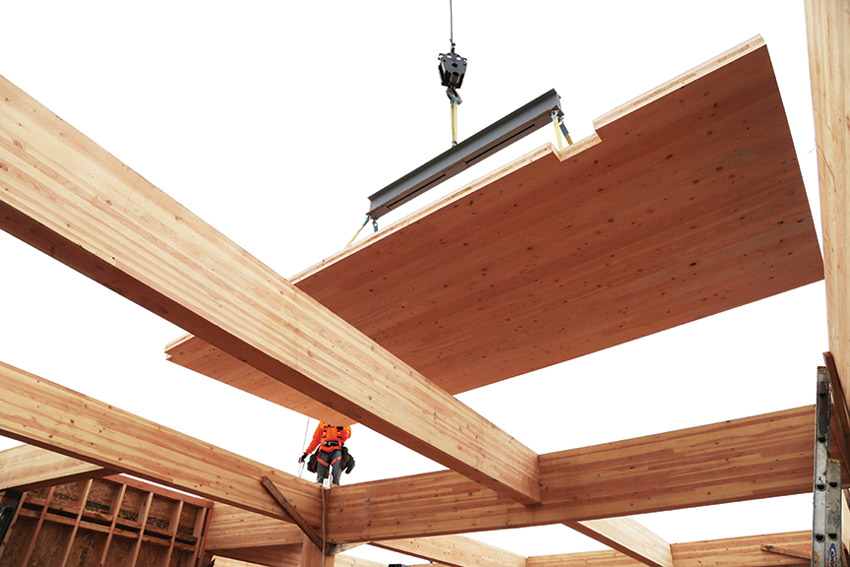
Image courtesy of LEVER Architecture
Building kits include prefabricated elements or sections that are then delivered and assembled on-site. The kit-of-parts approach, via panelization, is typical for midrise wood buildings.
Within panelization, it is helpful to understand the difference between open structural panels vs. closed structural panels. Open structural panels are a preassembled wall framework that is later fitted with other elements, such as insulation, exterior cladding, and weather barriers on-site. While this aids in time savings and flexibility, there is still a lot of site work involved. By contrast, closed structural panels are complete preassembled wall panels that may include windows, doors, plumbing, ducting, electrical, finishes, etc. Closed structural panels are larger and heavier so a crane is typically needed for on-site assembly.
Finished modules, on the other hand, are an entire building delivered and assembled on-site. Individual modules are joined together to make a single building. They are built in a factory, transported to the site, and when on-site, the modules can be placed side by side, end to end, or stacked, allowing a wide variety of configurations and styles in the building layout. Finish levels on modular units leaving the factory generally include plumbing, electrical, paint, flooring, fixtures, cabinets, and appliances. After the modules are craned into place, licensed sub-trades make electrical, plumbing, mechanical, and structural connections before finish work is completed and the building is prepped for occupancy.
Types of Prefabricated Wood Components
Prefabricated wood components may include light-frame walls, floors, and roof trusses or mass timber elements such as cross-laminated timber (CLT) panels, nail-laminated timber (NLT) panels, dowel-laminated timber (DLT) panels, and glue-laminated timber (GLT) columns and beams.
Light Wood Frame
Light wood-frame construction has long been the go-to framing choice for low- and midrise and, increasingly, commercial buildings. Cost-effectiveness, material use efficiency, ease of assembly, minimal environmental impact, and the ready availability of labor and materials make light wood-frame construction the most common type of wood construction in North America. Typical light-frame roof and floor systems consist of repetitive framing members such as rafters or trusses with wood structural panel decking. Framing components include solid sawn dimension lumber, I-joists, structural composite lumber, and parallel chord and pitched trusses. Oriented strand board (OSB) and plywood are used interchangeably as decking and sheathing material for floors, walls, and roof decks. There are several approaches to light wood-frame construction, and each is suited for a specific application, most often in Type III and Type V categories. As mentioned, on-site framing for light-frame construction is still the industry norm, but increasingly elements of these buildings are prefabricated off-site and assembled on the job.
Cross-Laminated Timber
Mass timber is a category of framing styles typically characterized by the use of large solid wood panels for wall, floor and roof construction. Cross-laminated timber panels are formed by stacking and gluing together successive perpendicular layers of wood. The layered stacks are then pressed in large hydraulic or vacuum presses to form an interlocked panel. The panel is then sized and shaped with a CNC machine into a construction-ready component. The number of layers in a panel can range from three to seven or more, and panels can have door and window openings as well as routings for electrical and mechanical systems installed before shipment to the building site. In addition to glued CLT, manufacturers have also developed a mechanically fastened CLT using carefully engineered fastening patterns rather than adhesives and pressure.
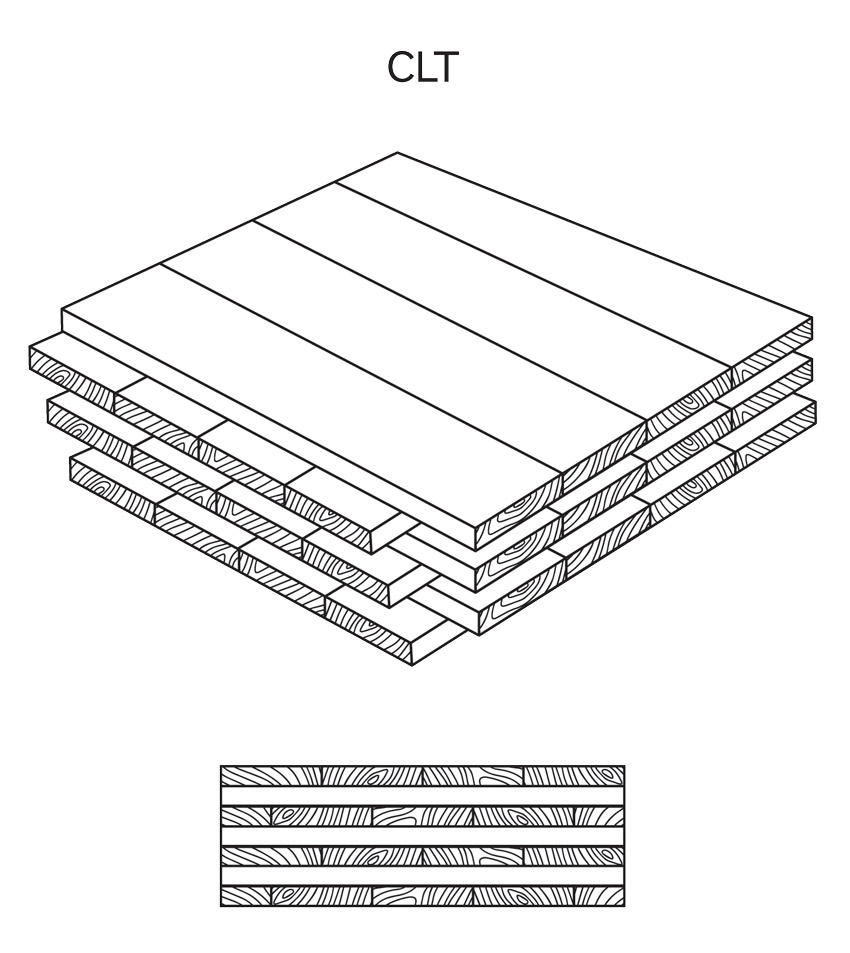
Cross-laminated timber panels are formed by stacking and gluing together successive perpendicular layers of wood. Often all machining and milling of holes is performed at the CLT producer’s plant based on the fabrication drawings and CNC machine files, and the product is shipped straight to site.
The cross-lamination process provides improved dimensional stability to the product, which allows for prefabrication of long, wide floor slabs, long single-story walls, and tall plate height conditions needed for clerestory walls or multistory balloon-framed configurations. By the nature of its design, CLT has inherent load-bearing strength and can serve as material for both vertical and horizontal assembly applications. Since wall, floor, and roof sections made of CLT are formed off-site in a factory, on-site construction time is much shorter. CLT can be used as a structural system in Type III, IV, and V buildings today and in tall wood buildings under alternate means.
Often all machining and milling of holes is performed at the CLT producer’s plant based on the fabrication drawings and CNC machine files, and the product is shipped straight to site. Other times, the product is shipped to a fabrication shop for further fitting of steel connections to speed up site erection.
Nail-Laminated Timber
Nail-laminated timber is a mass timber panel system that can be used for floor, wall, and roof structures. NLT floor and wall assemblies have been used for more than a century, particularly in warehouses where solid, sturdy floors were required; it is now being recognized again as a valid substitute for concrete slabs and steel decking in commercial and institutional buildings and residential buildings where it is often exposed to create a unique aesthetic. NLT is created from dimensional lumber stacked on edge—2x4, 2x6, 2x8, 2x10, or 2x12 at 11⁄2 inches on center—and fastened together with nails. Plywood sheathing is often added to one top side to provide a structural diaphragm. Plywood sheathing also allows the product to be used as a wall panel element.
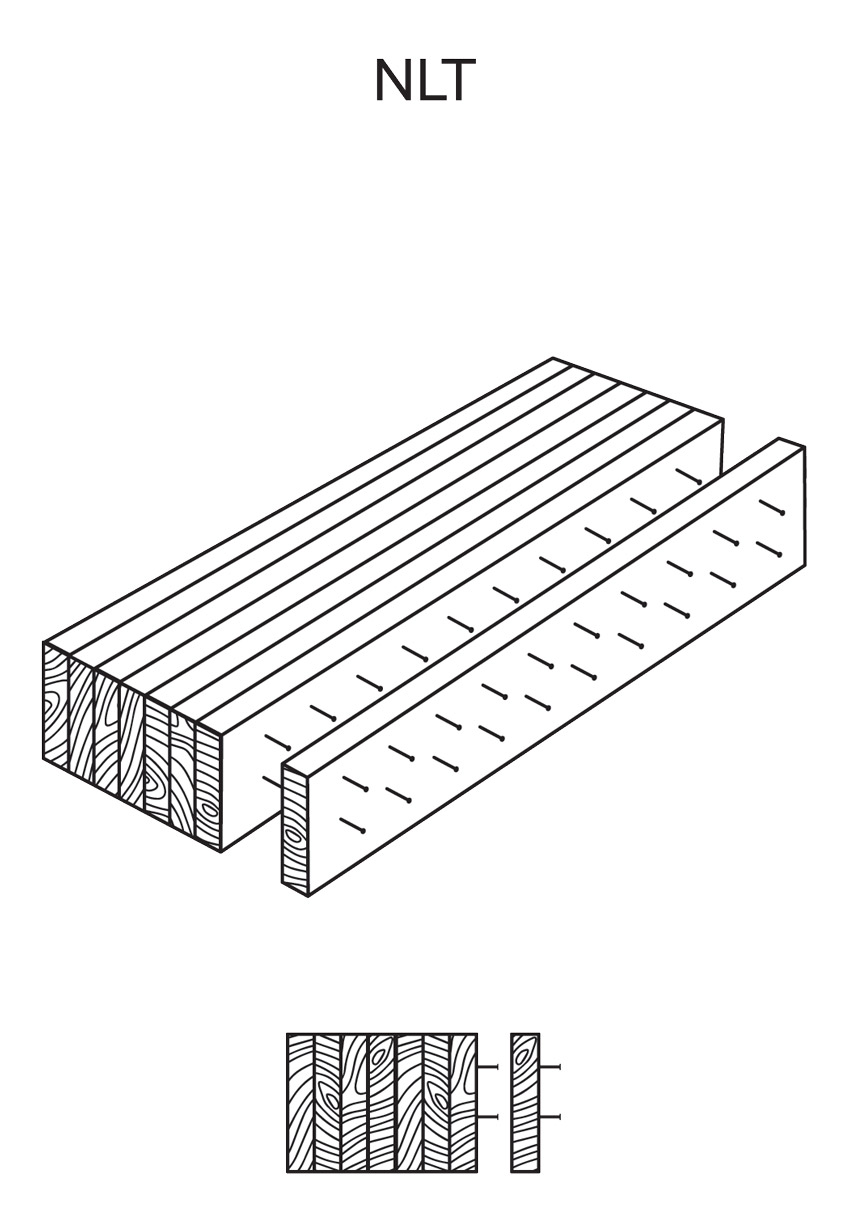
Nail-laminated timber is created from dimension lumber stacked on edge and fastened together with nails. Plywood sheathing is often added to one top side to provide a structural diaphragm and allow the product to be used as a wall-panel element.
Glue-Laminated Timber
Glue-laminated timber (also called glulam) is a structural engineered wood element commonly used for beams and columns in residential and commercial applications. To form a glulam component, dimensional lumber wood laminations are positioned according to their stress-rated performance characteristics. In most cases, the strongest laminations sandwich the beam in order to absorb stress proportionally and ensure the member’s longevity. The laminations are jointed end to end, allowing for long spans, and are bonded with a durable, moisture-resistant adhesive. The laminations’ grains run parallel with the member’s length to improve its strength.
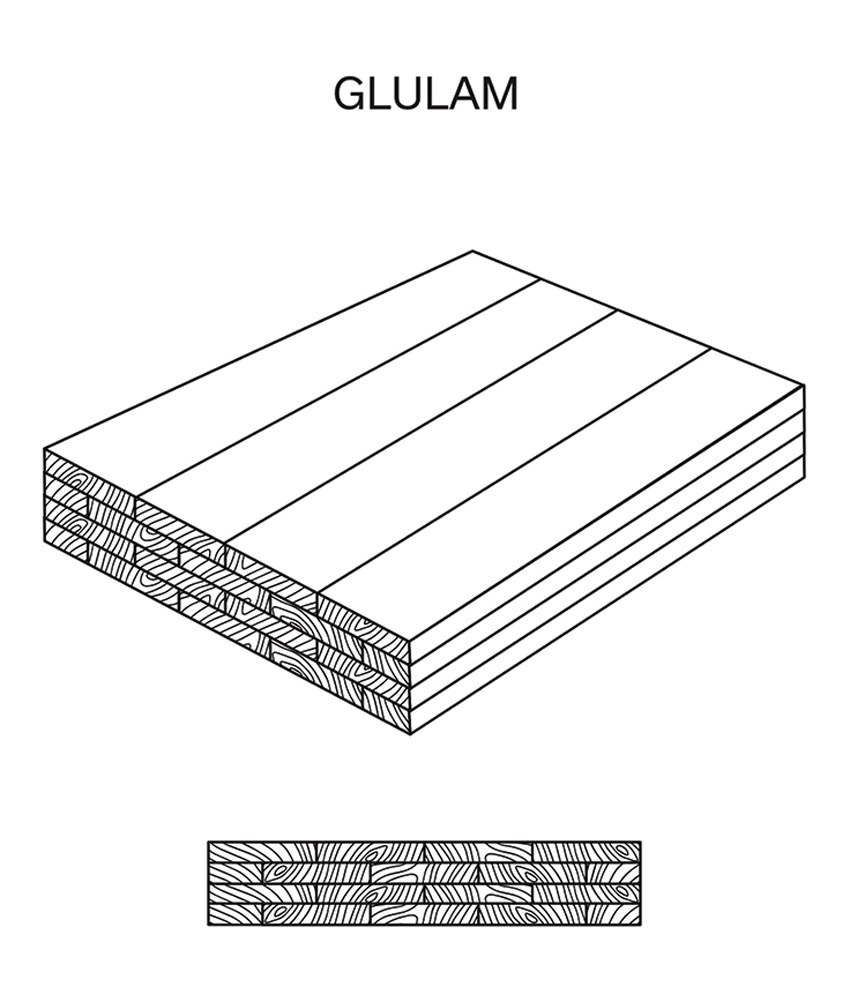
Glulam is stronger than steel at comparable weights, and it is stronger and stiffer than dimensional lumber.1 That makes the material a cost-effective choice for long, structural spans and tall columns with minimal need for additional support.
Glulam is stronger than steel at comparable weights, and it is stronger and stiffer than dimensional lumber.2 That makes the material a cost-effective choice for long, structural spans and tall columns with minimal need for additional support. Glulam is a highly visible form of mass timber in contemporary projects, with long spans framing signature designs that have been left exposed to take advantage of wood’s natural aesthetic. In addition to being used in floors, decks, and roofs, GLT and NLT mass timber panels are now used for timber elevator and stair shafts in six-story, light wood-frame residential midrise apartment buildings.
GLT also offers the advantage of being fabricated in controlled environments based on certified manufacturing standards. Like CLT, machining and milling of holes is often undertaken at the producer’s plant before the product is shipped to the site. Other times the panels are shipped to the fabricator’s shop for further fitting of steel connections.
Dowel-Laminated Timber
Dowel-laminated timber is a mass timber product that is wood and uses wood dowels as the connector. From larger panel sizes (12 feet by 60 feet) for faster erection times to a wide variety of wood species, DLT is a mass timber product that is ideal for floor, wall, and roof structures. DLT does not include any glue, chemicals, volatile organic compounds (VOCs), or nails, equating to a healthier indoor environment. And because there are no nails or metal fasteners, DLT is easy to process through CNC machines. Unique to DLT as a mass timber product, a wide variety of profiles can be integrated inexpensively into the bottom surface of the panel. Profiles are fully customizable to suit the particular performance and aesthetic requirements of each project.
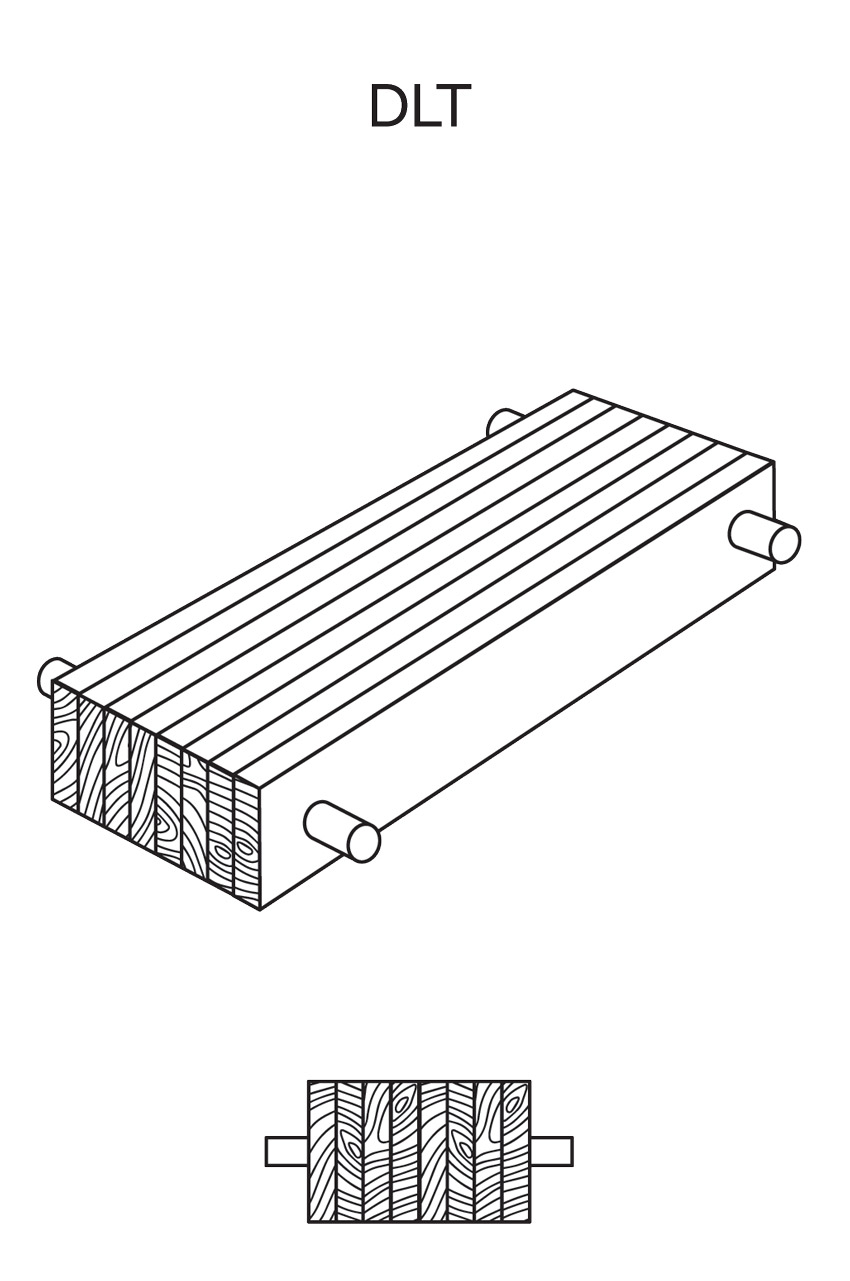
Dowel-laminated timber is a mass timber product that uses wood dowels as the connector and is ideal for floor, wall, and roof structures.
Benefits of Building with Prefabricated Wood Components
Speed and Installation Efficiency
Because wood panels are manufactured for specific applications, they’re well suited to a high degree of prefabrication at the plant, equating to speed and efficiency of installation. Panels are prefabricated, complete with pre-cut openings for doors, windows, stairs, service channels, and ducts, and shipped directly from manufacturer to job site so they can be quickly and efficiently lifted into place. This can shave months off the construction schedule. Many manufacturers ship panels with preinstalled lifting straps; contractors then use cranes to lift panels into place. In addition, prefabrication is safer because fewer crew members are needed to climb high on scaffolding. Because panels are designed for specific end-use applications, they are often delivered and erected using a “just-in-time” construction method, making wood products ideal for projects with limited on-site storage capacity. Prefabrication may also reduce the exposure of building components to wet weather. That being said, efficient construction can only be achieved when sequencing and project scheduling are determined up front and managed appropriately.
Design Flexibility
Wood can be used for an entire building or any combination of wall, floor/ceiling, and roof applications.
Its light weight and other characteristics make it highly adaptable to different types of projects, designs, and site conditions like soft soils or tight proximity to neighboring buildings. Kiln-dried wood products have superior dimensional stability, which is better for connection “stability” prior to installation and ensures good accuracy at installation. Wood elements can also be combined with other building materials, enabling flexibility in design, style, and finish architecture. When field modifications are needed, one of the advantages of wood over materials such as precast concrete is that changes can be made on-site with simple tools, pending approval by the engineer of record.

Because wood panels are manufactured for specific applications, they’re well suited to a high degree of prefabrication at the plant, equating to speed and efficiency of installation.
Thermal Performance and Energy Efficiency
Thermal conductivity is a measure of the rate of heat flow through one unit of thickness of a material subjected to a temperature gradient. The thermal conductivity of common structural wood is much less than the conductivity of metals with which wood is often mated in construction. It is about two to four times that of common insulating material.3
Solid wood panels also provide thermal mass, but the key measures of their thermal performance are U-value (coefficient of heat transfer) and R-value (insulating ability). Both are related to panel thickness. Thicker panels have lower U-values; they are better insulators and therefore require less insulation.
Because wood panels are manufactured using CNC equipment to precise tolerances, panel joints fit more tightly, resulting in a high degree of accuracy and better energy efficiency for the structure. Because the panels are solid, there is little potential for airflow through the system. As a result, an extremely tight building envelope can be achieved.
Resource Efficiency
Wood contributes to efficient use of the resource in several ways. One of the advantages of mass timber is that it can make use of smaller-dimension material that might not otherwise be used in structural applications. Also, since wood panels are manufactured specifically for each project, there is almost no job-site waste and manufacturers can re-use any fabrication scraps for stairs and other architectural elements or as biofuel.
In terms of overall resource use, the distinction between light frame and heavy construction is important. Mass timber was developed not as a replacement for light wood-frame construction but as a low-carbon alternative to heavy construction materials such as concrete and steel in building applications where light-frame construction is less appropriate, such as in taller buildings or office buildings where few partition walls and minimal floor vibrations are desired.
A mass timber building may require more total wood than a light-frame building, but when compared to steel or concrete in applications where all three are potentially applicable, advantages such as renewability, carbon offsets, low embodied energy, and operational energy efficiency make mass timber an environmentally preferable choice.
End Notes
1 Stock Glulam Resource Kit. APA – The Engineered Wood Association. Web. 8 January 2019.
2 Ibid
3 What is the thermal conductivity of wood and how does it compare to other materials? American Wood Council. Web. 8 January 2019.
Design Guidance and Resources
There are many resources available to architects and engineers designing mass timber projects.
- For general information, the Think Wood website (www.thinkwood.com) offers an expanding library of materials on mass timber products, research, building examples, and developments related to tall wood buildings.
- The National Design Specification (NDS) for Wood Construction (www.awc.org) is the IBC-referenced design standard for lumber, glulam, SCL, and CLT, including fire design, fasteners and connections, etc. A mass timber building in the United States cannot be designed without the NDS.
- The U.S. CLT Handbook (www.thinkwood.com) includes detailed technical information on the use of CLT. It should be used in conjunction with information provided by manufacturers since most CLT currently available in North America is propriety (i.e., layups aren’t standard across suppliers).
- APA Product Reports (www.apawood.org/product-reports) signify a product’s compliance with relevant provisions of the model building codes. The L-Series covers products manufactured from lumber, veneer, or other wood base, such as glulam and structural composite lumber (SCL).

